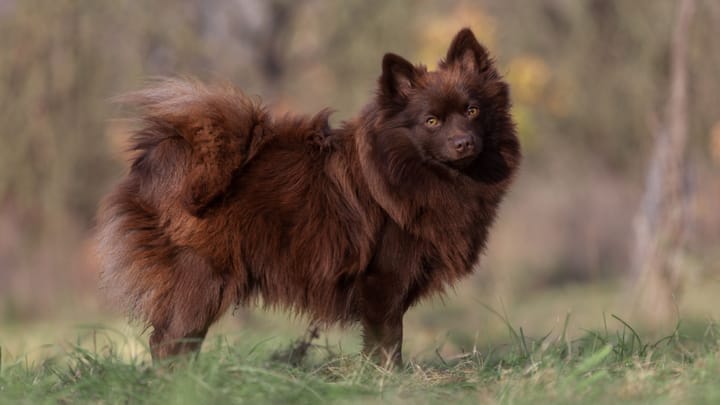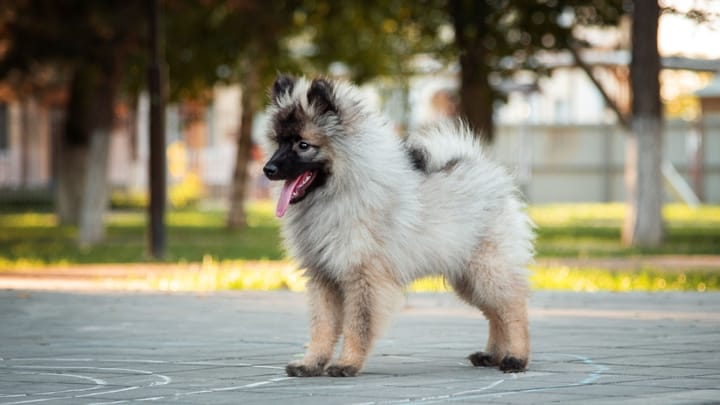Pomeranian or miniature Spitz
Other names : Deutscher Spitz, Wolfspitz, Keeshond, Pomeranian, Toyspitz


There are five different sizes of the German Spitz dog, ranging from the smallest, the Pomeranian, to the largest, the Keeshond. They are all cheerful, jovial and affectionate but reserved around strangers, which makes them good guard dogs. They are intelligent and docile, making them easy to train and suitable for many households, especially those with children.
|
Life expectancy |
The Pomeranian or miniature Spitz has a life expectancy of between 12 and 16 years |
|
Temperament |
|
|
Size |
Medium
|
|
Adult size |
Female
Between 7 and 22 in
Male
Between 7 and 22 in
|
|
Adult weight |
Female
Between 7 and 44 lb
Male
Between 7 and 44 lb
|
|
Coat colour
Each variety is divided into sub-varieties according to their colour.
The white German Spitz and the black German Spitz are not the most common colours but are nevertheless highly appreciated by breed lovers. |
Black White Brown Blue Red |
|
Type of coat
The coat is long. The coat is smooth and dense, a thick undercoat, with a collar around the head and a thick plume on the tail. |
Long |
|
Eye colour
Eyes are dark in colour. |
Brown
|
|
Purchase price |
The Pomeranian or miniature Spitz costs between £580 and £670 |
Famous historical figures were the proud owners of this much appreciated breed, such as Catherine of Russia, Marie-Antoinette, Mozart, Michel Ange and Emile Zola.
There are a lot of Pomeranian mixed breeds, discover 6 of the most famous ones.
More details about the Pomeranian or miniature Spitz
Pomeranian or miniature Spitz: Origins and history
They are very old dogs that descend directly from the Canis familiaris palustris rutimeyer that lived in peat bogs in the Stone Age, and from the Spitz that existed in the Neolithic period in the lake cities. The German names of the different varieties are Wolfspitz, Grosspitz (large), Mittelspitz (medium), Kleinspitz (small) and Zwergspitz (dwarf). The FCI officially recognised the breed in 1957.
Physical characteristics of the Pomeranian or miniature Spitz
The head is reminiscent of that of a fox, with upright and triangular ears; the eyes are almond-shaped and the forehead broad and round. The muzzle is not very long and narrows from the skull to the tip of the nose. The legs are of medium length, well proportioned with the body which fits into a square, and is perfectly perpendicular. The tail is carried gracefully wrapped over the back.
FCI classification of the Pomeranian or miniature Spitz
-
Group 5 - Spitz and primitive types
-
Section 4 : European Spitz
Pomeranian or miniature Spitz: Varieties
- Spitz Moyen
- Keeshond or Wolfspitz
- Giant Spitz
- Medium Spitz
- Small Spitz
- Pomeranian or miniature Spitz
Pomeranian or miniature Spitz: Characteristics
Pomeranian or miniature Spitz: Behaviour
Training a Pomeranian or miniature Spitz
Very attached to their master, these dogs want to learn and spend time with their owners.
Naturally, this facilitates education and training.
However, they are very sensitive and will not accept or forgive any form of brutality. Therefore, patience, consistency and care must be demonstrated during training sessions.
Pomeranian or miniature Spitz: Lifestyle
Breed compatibility Pomeranian or miniature Spitz
Pomeranian or miniature Spitz: Purchase price
The price of a German Spitz varies according to their origins, variety, age and sex. A dog registered with the KC are generally sold for around £670.
To look after a dog like the German Spitz, it will cost about £20 per month for the smallest and up to £35 for the largest.
Pomeranian or miniature Spitz: Shedding
Heavy !
Because of their thick coat, hair loss during the moulting period is significant; brushing should therefore be very frequent, even daily. The rest of the time, hair loss is moderate.
Pomeranian or miniature Spitz: Grooming
Despite appearances, maintaining the coat of this breed is not complicated but still requires special attention. The coat should be brushed at least once a week and backwards to reach the dog’s dense undercoat.
Frequent baths should be avoided to avoid damaging the protective and aesthetic qualities of the fur. A maximum of two grooming/baths per year is more than enough.
However, for shows, grooming should be carried out by a professional to respect the standard and to avoid distorting the appearance of the dog.
Pomeranian or miniature Spitz: Health
Life expectancy of a Deutscher Spitz is around 14 years.
Far from being the fragile dog we imagine, this rustic dog is rather robust.
Their thick coat protects them from both cold and hot temperatures. However, be careful not to let them be exposed to the sun for too long to avoid heat stroke.
The double coat of this dog, composed of a beautiful outer-coat and abundant undercoat, gives them very good protection against the cold. The larger varieties can even live outdoors.
A particular attention has to be given to the food you give to your Spitz since these dogs tend to get fat quickly if their portions are not adapted to their daily physical activities.
- Alopecia (skin condition)
- Tracheal collapse (respiratory tract disease)
Do you want a Pomeranian or miniature Spitz dog ?
Frequently asked questions
How much is a Pomeranian?
The price for a Pomeranian will vary according to their origins, variety (Keeshond, Giant Spitz, Medium Spitz, Small Spitz, Pomeranian or miniature Spitz), age and sex. If a dog is registered with the Kennel Club, the price will be around £670. If the dog isn't registered, the price is generally around £580.
Do Pomeranian like to cuddle?
Yes, Pomeranians love to cuddle. Historically they lived in packs and would cuddle to keep themselves warm, and show love and affection towards one another. So if you are looking for a loyal, loving and affectionate dog that you will cuddle all the time, the Pomeranian is the breed for you!
Are Pomeranians easy to train?
Pomeranians are easy dogs to train. Indeed, they love spending time and pleasing their owners so training is easy. As long as the owner is constent in the training sessions and uses positive reinforcement, then you'll have a happy and well behaved dog by your side.
Does the Pomeranian bark a lot?
Yes, although the Pomeranian is a small breed, it barks a lot. As well, their bark is high pitched and powerful, and if they hear a unfamiliar noise or meet a stranger, you'll be sure your Pomeranian will let you know.
It would help to train your dog to stop barking when you ask him too.
How long do Pomeranian dogs live for?
The lifespan of a Pomeranian dog is between 12 to 16 years old.
1 comment
-
1 comment out of 1
Are you sure you want to delete the comment?








